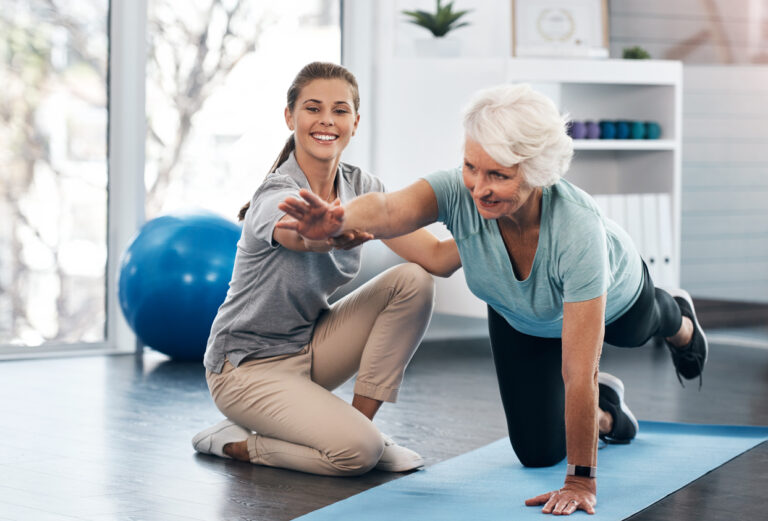Physical therapy as an essential part of the everyday routine of the elderly needs to be taken seriously, especially if there were any kind of trauma in the past.
After reaching a certain age, 60 and older, it gets harder to move, the risk of falls is getting more real, and joints lose their flexibility and strength. This can result in losing independence and constant difficulties in performing the regular, everyday routine.
Here are some tips and examples of therapeutic exercises for seniors.
What is therapeutic exercise?

This type of exercise helps restore muscular and skeletal function and corrects impairments to reduce your pain and increase flexibility. The scientific evidence demonstrating the beneficial effects of exercise is indisputable, and the benefits of exercise far outweigh the risks in most adults. For most adults, an exercise program including aerobic, resistance, flexibility, and neuromotor exercise training is indispensable to improving and maintaining physical fitness and health.
Therapeutic exercise is one of the tools physical therapists commonly use during patient rehabilitation. They may be prescribed for various issues, including postoperative care, common orthopaedic injuries and conditions of a specific body part or joint, and as part of recovery.
Therapeutic exercise is crucial for improving range of motion, muscle strength, and overall functional capacity. It plays a vital role in preventing complications, promoting healing, and restoring optimal physical performance. Physical therapists carefully design exercise programs tailored to each patient’s unique needs, ensuring safe and effective rehabilitation. Check out Let’s Get Care if you are interested in aged care facilities that prioritize personalized therapeutic interventions. They offer comprehensive services to support elderly individuals in their recovery journey.
One may wonder how therapeutic exercise differs from regular physical activity. The answer is simple, physical activity refers to the contraction of skeletal muscle that produces bodily movement and requires energy while exercise is a physical activity that is planned and performed with a certain goal.
The best and most commonly prescribed exercises for older adults are:
- Strengthening exercises
- Endurance exercises
- Flexibility exercises
- Balance and coordination exercises.
Strengthening exercises
This type of exercise is aimed at building up muscle tissue since one of the most disturbing things for seniors is losing strength. To stay strong and be able to perform regular activities, like laundry, housekeeping, shopping and even self-care, it is essential to tone up your muscles.
The simplest examples may be:
- Standing push-ups. There is no need to lie down, you can use a wall or a counter. Just press your palms on the surface, feet on the floor, and lean forward bending your elbows. Repeat as often and as many as you can.
- More advanced exercise is Sitting–standing. With the help of a chair, pretend like you are going to sit down, bending your knees and lowering yourself toward the seat. But, before you touch it, gradually stand again. Bend from the hips, remember to breathe and use your leg and abdominal muscles. After some time, you can add some weights to make it more complicated.
Endurance exercises

This kind of activity requires high intensity with constant monitoring of the heart rate. Doctors recommend walking, as one of the forms of endurance activity, saying that walking at least 2 miles a day can lower their mortality risk by 50 per cent. Other good forms of endurance training are swimming, cycling, dancing, walking up stairs instead of taking the elevator, golf (walking), gardening or heavy yard work, and low-impact aerobics.
Flexibility exercises
For many seniors, not moving becomes the default, even though that makes things worse in the long run. Stretching exercises can help keep you mobile by reducing muscle pain and improving flexibility.
- Neck stretching. While seated comfortably, tip your chin down to your chest, then gently turn your head to one side and count to 15. Repeat for the opposite side. this exercise increases mobility—which is important for seniors who drive and need to be able to look around.
- Back stretching. You can do this even in bed or any other flat surface—no need to get on the floor. Lie on your back with your knees bent and your feet flat and close together. Gradually tip your legs down to one side, keeping your hips flat on the surface. Repeat as many times as you can.

Balance and coordination exercises
As we mentioned earlier, balance is crucial for older people, since they are more vulnerable to accidental falls. The best exercises would be:
- Standing on one leg. Lift your right knee and stand only on your left leg for 10 seconds, then change. You can hold it to the wall or the chair if you need extra support.
- Eye-tracking exercise. Hold your thumb in front of your face. Then move it as far as you can to the left, then to the right. Keep your head still, and follow only with your eyes.
- Side-to-side stepping. You can start by moving across the room side-to-side, and then you can add small obstacles that you’ll need to step over.
Our LifeChoice specialist can work with you to develop an care plan tailored to your needs and provide compassionate support during your hospice journey.

